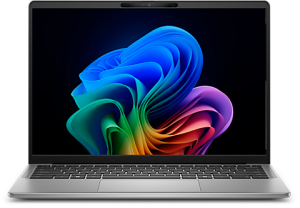It’s almost 10 years later. My old Dell still works well, but it now shows some flaws. The battery only lasts a few minutes. The charger is broken and the power cords are visible. The plastic frame around the screen has partially disintegrated, leaving behind a strange greasy residue. It’s not possible to upgrade to Windows 11 because I’m missing some modern components. A few drawbacks, but as long as the computer hangs by its power cord, it still works perfectly. Nevertheless, I found it time for some refreshing new hardware.
 My new Dell (arriving soon):
My new Dell (arriving soon):
Name: Dell Latitude 7455
CPU: Qualcomm Snapdragon X Elite
Memory: 32 GB
Harddisk: 512GB SSD
Why Qualcomm?
I initially had some reservations about getting a Qualcomm processor. They are more expensive, and quite new, which means they may not perfectly compatible with some hardware or software. I worried that it might be harder to get things to work properly, and if I needed to troubleshoot issues myself, it could take a lot of time or effort. However, since I don’t use my laptop for gaming and I don’t require many external devices, I thought I should be okay.
The alternative is an Intel or AMD processor. These would always work, are cheaper, and fast. Normally, they would be the logical choice.
Intel and AMD produce X64 CPUs based on a CISC architecture (Complex Instruction Set). This means that these processors have high speed during numerical tasks, but slower speeds for data transfer. In contrast, ARM CPUs, such as those used in Snapdragons, are based on a RISC architecture (Reduced Instruction Set). This implies that these CPUs have lower bus bandwidth, but are fast for simple tasks. Apple has been using a RISC architecture with its M processors for some years now.
When I bought my first MacBook, it came with an M1 CPU, and this initially required quite a bit of extra effort to install emulators and get stuff to work correctly. I was impressed with the performance when I got my MacBook. Two years later, I’m still happy to see that the AI reacts much faster than an Intel machine. This made me reconsider my initial doubts about Qualcomm processors and think they might be worth considering for their future potential. So, I decided to give it a try.
Why Dell?
My shortlist had two laptops on it. A Microsoft Surface Laptop 7 and a Dell Latitude. The Microsoft machine looks really promising, but I was unable to configure one easily with 32GB memory, and it had a glossy screen, with I viewed as a minor negative point. The Dell was easier to configure, but was a bit more expensive. The screen was not quite as good as the Microsoft one, but it was not glossy which I see as a plus.
I found out online that the Microsoft laptop is build really well, better than the Dell, but I remember that my old Dells were all very well build, at least the Latitudes are very sturdy machines so I just went with my experience. After a few days spend sleeping on the issue it was clear to me that I would be happier investing in the Dell, so that’s what I did.
Why 32GB?
Memory is expensive. It is like a small harddisk, but as fast as lightning. If you have enough memory your computer will be fast. Previously my Dell laptops were all bought with the maximum allowed memory, and I would buy an extra memory strip together with the system, so I could double the memory myself once I received the machine. Even after years of operation this resulted in fast and responsive hardware.
My new system cannot be upgraded after buying the system, so I had to get the maximum amount of memory right away. Right now the minimum about of memory seems to be 8gb, but the normal amount is 16GB. By doubling this I should have enough for a couple of years into the future. I think AI applications like it when you have lots of memory available.
Why 512GB?
Harddisks are essential to store loads of data, but being realistic, the harddisk in my laptops are used for the operating system, and for a couple of applications. The rest is temporal storage for backups, projects, etc. Long term storage is done on external harddisks. Only looking at my photos I have way over 2TB already (starting storing my digital images since 1994). External harddisks can be used on any system and a copy can easily be stored in different physical locations.
What else?
I got a Dell with a 14″ screen. A small screen makes for a smaller laptop, which is easier to take with you. A small screen usually means that you do not get a numerical keypad, but I never use the keypad anyway, so there is no loss there.
When?
My new Dell is produced in China. It is on its way right now, but the estimated arrival is in March. Almost one month waiting impatiently. That is probably the price I am paying for living in paradise on an island.
Disclaimer: A few days after deciding on the Dell I took another look at the Microsoft store, and found that getting a system with 32GB memory was possible, but at a price much higher than the Dell. I guess it confirmed I had made the right choice.
